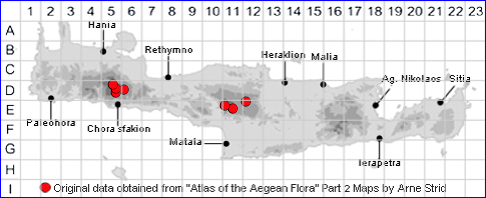
SPECIES DESCRIPTION
BOLANTHUS CREUTZBERGII subsp. CREUTZBERGII
Family:- CARYOPHYLLACEAE
Common Name:- None
Synonyms:- None
Meaning:- Bolanthus Meaning uncertain.
Creutzburgii (L) After Nikolaus Creutzburg. German geographer.
General description:- A dwarf, laxly caespitose perennial, with a woody base. The
whole plant densly hairy with some longer, glandular and eglandular hairs.
Stems:-
a) 1.5-6 cm.
b) Ascending to erect.
Leaves:-
1) Blade:
a) 2-5 x 0·5-1·5 mm.
b) spatulate to oblanceolate.
Flowers:-
a) in capitate clusters or forked.
b) axis divided into two equal branches (dichotomous) with one flower per node.
1) Bracts:
a) leaf-like, ± equalling the calyx.
b) stem (pedicel) very short.
2) Calyx:
a) 2.5-4 mm.
b) ellipsoid.
c) tube 5-ribbed.
d) teeth, narrowly triangular.
3) Petals:
a) linear-spathulate, somewhat exceeding the calyx.
b) white with a deep purple transverse stripe near the middle or base.
Fruit:-
1) Capsule:
a) equalling the calyx.
2) Seeds c. 1 mm.
a) comma-shaped, black.
b) minutely papillose.
Key features:-
1) Stems not more than 6 cm.
2) Calyx 4-6 mm, tubular.
3) Petals linear-spathulate.
Habitat:- Rocky limestone slopes and screes. (800-)1600-2000 m.
Distribution:- Endemic to the Lefka Ori and Psiloritis Massifs. Rare.
Flowering time:- May-July.
Photos by:- Zacharias Angourakis
Status:-
Conservation status (for threatened species): Vulnerable (V) according to IUCN
1997.
Protection status (for threatened species): Greek Presidential Decree 67/1981
